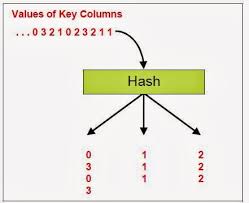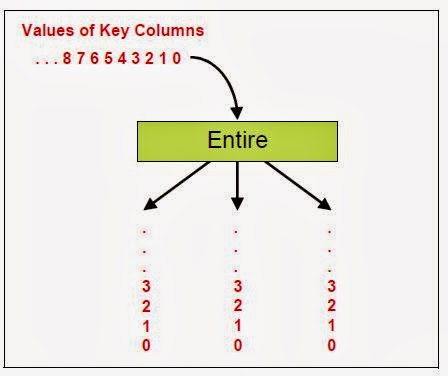If one or more key columns are text then we use the Hash partition technique. Basically there are two methods or types of partitioning in Datastage.

Data Partitioning And Collecting In Datastage
Show activity on this post.

. If set to false or 0 partitioners may be added depending upon your job design and options chosen. Same Key Column Values are Given to the Same Node. The records are partitioned randomly based on the output of a random number generator.
Data Partitioning And Collecting In Datastage Data Warehousing Data Warehousing. But this method is used more often for parallel data processing. The message says that the index for the given partition is unusable.
Expression for StgVarCntr1st stg var-- maintain order. Partition techniques in datastage. Round robin partition is another partitioning technique to uniformly distribute the data on each of the destination.
When InfoSphere DataStage reaches the last processing node in the system it starts over. Partition by Key or hash partition - This is a partitioning technique which is used to partition data when the keys are diverse. Partition techniques in datastage.
Collecting is the opposite of partitioning and can be defined as a process of bringing back data partitions into a single sequential stream one data partition. Determines partition based on key-values. This method is similar to hash by field but involves simpler computation.
But I found one better and effective E-learning website related to Datastage just have a look. All key-based stages by default are associated with Hash as a Key-based Technique. This is commonly used to partition on tag fields.
So you could try to rebuild the correponding index partition by the use of. DataStage provides partitioning and parallel processing techniques which allow the DataStage jobs to process an enormous volume of data quite faster. Partition is to divide memory or mass storage into isolated sections.
In most cases DataStage will use hash partitioning when inserting a partitioner. Existing Partition is not altered. Rows are randomly distributed across partitions.
Differentiate Informatica and Datastage. This method is the one normally used when InfoSphere DataStage initially partitions data. Hash Partitioning is one of the most popular and frequently used techniques in the Data Stage.
This is commonly used to partition on tag fields. Datastage is a tool set for designing developing and running applications that populateone or more tables in a data warehouse or data mart. Partition by Key or hash partition - This is a partitioning technique which is used to partition data when the keys are diverse.
Datastage supports a few types of Data partitioning methods which can be implemented in parallel stages. The data partitioning techniques are. The DataStage developer only needs to specify the algorithm to partition the data not the degree of parallelism or where the job will execute.
Create index index_name rebuild partition partition_name with the fitting values for index_name and partition_nme. Using partition parallelism the same job would effectively be run simultaneously by several processors each handling a separate subset of the total data. Using this approach data is randomly distributed across the partitions rather than grouped.
Rows are evenly processed among partitions. All CA rows go into one partition. This method is the one normally used when InfoSphere DataStage initially partitions data.
DataStage provides partitioning and parallel processing techniques which allow the DataStage jobs to process an enormous volume of data quite faster. DataStage PX version has the ability to slice the data into chunks and process it simultaneously. The records are partitioned using a modulus function on the key column selected from the Available list.
Free Apns For Android. The records are hashed into partitions based on the value of a key column or columns selected from the Available list. Rows distributed independently of data values.
Data Partitioning And Collecting In Datastage Data Warehousing Data Warehousing All key-based stages by default are associated with Hash as a Key-based Technique. Replicates the DB2 partitioning method of a specific DB2 table. Hash Partitioning is one of the most popular and frequently used techniques in the Data Stage.
Server jobs were doesnt support the partitioning techniques but parallel jobs support the partition techniques. Divides a data set into approximately equal-sized partitions each of which contains records with key columns within a specified range. Agenda Introduction Why do we need partitioning Types of partitioning.
Under this part we send data with the Same Key Colum to the same partition. Determines partition based on key-values. All MA rows go into one partition.
The round robin method always creates approximately equal-sized partitions. This answer is not useful. Key less Partitioning Partitioning is not based on the key column.
If Key Column 1. Collecting is the opposite of partitioning and can be defined as a process of bringing back data partitions into a single sequential stream one data partition. Partition by Key or hash partition - This is a partitioning technique which is used to partition data when the keys are.
Introduction Strength of DataStage Parallel Extender is in the parallel processing capability it brings into your data extraction and transformation applications. When InfoSphere DataStage reaches the last processing node in the system it starts over. DataStage provides partitioning and parallel processing techniques which allow the DataStage jobs to process an enormous volume of data quite faster.
This method is useful for resizing partitions of an input data set that are not equal in size. Partition by Key or hash partition - This is a partitioning technique which is used to partition. Rows distributed based on values in specified keys.
In DataStage we need to drag and drop the DataStage objects and also we can convert it to. APT_NO_PARTITION_INSERTION simply control whether or not partitioners will be added where needed. Each file written to receives the entire data set.
There are various partitioning techniques available on DataStage and they are. DataStage provides the options to Partition the data ie send specific data to a single node or also send records in round robin fashion to the available nodes. Partition techniques in datastage.
This method is the one normally used when InfoSphere DataStage initially partitions data. If set to true or 1 partitioners will not be added. Create index index_name rebuild partition partition_name with the fitting values for index_name and partition_nme.
One or more keys with different data types are supported. This post is about the IBM DataStage Partition methods. The round robin method always creates approximately equal-sized partitions.
Rows distributed based on values in specified keys. Key Based Partitioning Partitioning is based on the key column. Types of partition.
Partition by Key or hash partition - This is a partitioning technique which is used to partition data when the keys are diverse. This method is the one normally used when DataStage initially partitions data.

Dev S Datastage Tutorial Guides Training And Online Help 4 U Unix Etl Database Related Solutions Data Partitioning Collecting Methods Examples

Modulus Partitioning Datastage Youtube

Partitioning Technique In Datastage

Partitioning Technique In Datastage

Partitioning Technique In Datastage

Datastage Types Of Partition Tekslate Datastage Tutorials

Hash Partitioning Datastage Youtube

Data Partitioning And Collecting In Datastage Data Warehousing Data Warehousing
0 comments
Post a Comment